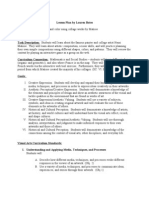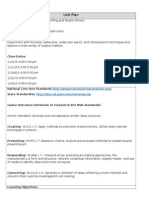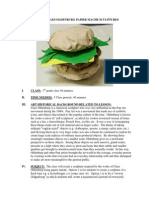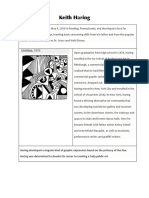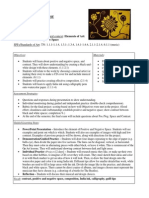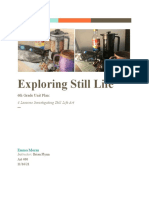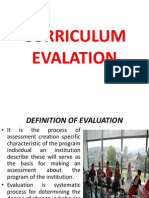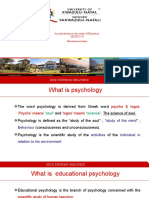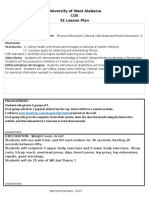Art Unit Lesson Plan
Art Unit Lesson Plan
Uploaded by
api-318122480Copyright:
Available Formats
Art Unit Lesson Plan
Art Unit Lesson Plan
Uploaded by
api-318122480Original Title
Copyright
Available Formats
Share this document
Did you find this document useful?
Is this content inappropriate?
Copyright:
Available Formats
Art Unit Lesson Plan
Art Unit Lesson Plan
Uploaded by
api-318122480Copyright:
Available Formats
Art Integration Unit Plan Template
Art Integration Unit Plan Template
LTC Art for Children
Unit Title & Big Idea: (Define the BIG IDEA?) What is the big idea that is being investigated in this lesson? How will
you connect the big ideas about art and artists work with the art making part of this lesson?
The big idea of this lesson is nature. This will be a science lesson that is connected to nature as well as art.
Grade Level/Class Periods
Required:
4
Unit Overview/Summary: Why is this important to teach? What do you hope to accomplish?
This unit of nature exploration is important to teach students about ecosystems that can be found
near the school. Part of this lesson involves making observations and inferences about nature
around the school. Another aspect of this lesson will be to incorporate print making into showing
the community of an environment. Finally students will write about the impact of humans on the
ecosystem located near the school. In this big idea of nature I want for students to be able to see
the interactions and connections between organisms and the ecosystem that they live in.
Materials/Equiptment/Etc:
MATERIALS, TEACHING
RESOURCES/REFERENCES(Books (Teacher and
Childrens), posters, articles,
websites) and PREPARATION
REQUIRED- what materials,
tools, and resources do you need
for this class? What do you need
to practice and prepare for this
lesson? What did you learn from
creating your teaching exemplar?
Science notesbooks
Writing utensils
Cardstock
Rollers
Paint for print making
Key Concepts (3-4)
What will students learn and KNOW about art and art making from this
lesson?
List as facts about art and artists and works of art. What will they learn
from an art, art history, and art criticism discussion? What will they learn from
the art production part of the lesson? What key concepts from other core
subjects will they uncover?
The students will be using print making to emphasize the connection
Essential Questions (3-4) What questions guide the investigation in this
lesson?
What will students discover and investigate both about art and art
making? What will you ask that will guide the purposeful exploration of
materials and ideas that will produce meaningful content to the creative
production?
What materials from the ecosystem around the school can be
used to making a collagraph?
How can students show the connectedness of organisms in
Art Integration Unit Plan Template
between organisms. Students will be using materials from outside to use as
their items on the print stamp. Students will be able to see what items work
well with the print making process as well as items that do not.
Key concepts from other subjects include being able to write
observations that they see on the nature walk. Students will also write about
what they think about human impact on the ecosystems around the school.
an ecosystem through their own print making process?
Is there aspects about print making that make it difficult to
use nature as the materials for print making?
Unit Objectives: (Excellent resource at http://www.teachervision.fen.com/curriculum-planning/new-teacher/48345.html?for_printing=1&detoured=1)
What learners will DO? List beginning with the student will
*(NOTE: Evidence of the objectives and concepts attained make up your assessment criteria below)
The students will go on a nature walk through the ecosystem located near the school, while the students are walking, they will write 4 to 5 observations on
what they are seeing and how organisms are connected.
Students will collect materials on a second nature walk, to be used in making their own collagraph.
Students will write 5-10 sentences about the impact of humans on the ecosystem around the school.
Grade Level Expectations (GLEs) (3-4) (GLEs VISUAL ARTS)
National Core Art Standards
(http://www.nationalartsstandards.org)
Creating: Anchor Standard #1: Generate and conceptualize
artistic ideas and work.
Creating: Anchor Standard #2: Organize and develop artistic
ideas and work.
Creating: Anchor Standard #3: Refine and complete artistic
work.
Responding: Anchor Standard #7: Perceive and analyze artistic
work.
Core Academic Standards (Common Core State Standards)
(3-
4)
(http://www.corestandards.org/)
4-4.1.A: Changes in ecosystems and interactions of
organisms with their environments. Identify the ways a
specific organism may interact with other organisms or with
the environment. (e.g., pollination, shelter, seed dispersal,
camouflage, migration, hibernations, defensive mechanism)
4-4.1.D: Changes in ecosystems and interactions of
organisms with their environments. Identify examples in
Missouri where human activity has had a beneficial or
harmful effect on other organisms (e.g., feeding birds,
littering, hunting, restoring green space)
Art Integration Unit Plan Template
Content Areas Integrated:
1. Visual Art
2. Science
3. Writing
Lesson Titles in Sequence/Order with TIME and MATERIALS
needed for each portion
1. Nature Walk: This will take 30 minutes. Students will
need science notebooks and writing utensil
2. Print making: This will take 20 minutes. The teacher will
model how to make a collagraph. The teacher will
already have come prepared with a completed stamp.
The teacher will need paint, rollers, and paper.
3. Print making: This will take up to 1 hour, can be made
into several days if needed. Students will find materials
to use for their stamp from a second nature walk.
Students will need paint, rollers, and card stock to print
on.
4. Journaling: This will take 25 minutes. Students will need
their science journals, their prints they have made, and
a writing utensil.
Identify & define common vocabulary/concepts that
connect the art form with the other identified subject area(s):
Collagraph: a print making process where the artist
makes a stamp, rolls paint on it, and then stamps a
new sheet of paper
Brief Lesson Descriptions (2-3 sentences each)
1. Nature Walk: On this nature walk students and the
teacher will walk around the school and make
observations. The teacher will encourage students to
notice examples of organisms adapting to their
environment. The teacher will also point to any human
signs that they see in the environment. Students will
discuss if the human impact is positive or negative.
2. Print Making: This will be the teacher modeling how to
make a collagraph print. The teacher will already have
the materials that they want to create their print. It
may be better to make their stamp ahead of time, and
just explain to the students about the importance of
different materials and heights.
The teacher will
demonstrate how to make a collagraph.
3. Print Making: This is when the students will be making
their own collagraph. First students and the teacher
will go on another nature walk to collect materials for
the print making. Students will then create their
stamp. Most likely it would need to be another day
when they move onto creating a print so the stamp
has time to dry. Students will use the rollers and paint
to make their own prints.
4. Journaling: Students will write in their science journals
about the print that they made as well as human
impact on the environment around the school.
Art Integration Unit Plan Template
What student prior knowledge will this unit require/draw upon?
This unit will require that students know what observations are. Students will also be asked to take notes on their
observations while going on the nature walk. Students will have previously been taught what observations are. Students will
also know how to write down notes about their thoughts.
Students will not need to have prior knowledge on the art making process of collagraphy. Students will be explicitly taught
how to make the collagraph.
What activities will you use to engage students in imagining, exploring, and/or experimenting in this unit?
Describe, specifically, how you will allow the students to engage with the media, the concepts, and other objectives in a
playful manner before they are expected to produce the final work. This section should accentuate how the PROCESS
informs the product
Students will be given the chance to explore with the collagraph making process before they begin to make their actual prints.
The teacher should allow for students to practice with the rollers, to see how the paint needs to get tacky as they roll it out.
The teacher should plan about 5-10 minutes for the students to experiment and get familiar with the rollers, paint, and print
making process.
Students will then be given a large amount of time to work on their print making. Since artists typically make several prints,
the students will do this as well. The students will have the chance to practice making many prints from their stamp.
How will this unit permit/encourage students to solve problems in divergent ways?
Deeply describe how this lesson allows for students to solve problems, aesthetically as well as scholastically? What about this
lesson allows for divergent outcomes?
In the print making process, the teacher will leave much open to interpretation for the students. The instructions will be to
create a print that shows how organisms and objects in nature are connected. The students will use materials found in nature
around the school to do this. Other than that, the student will be left to their own ideas on what to create. Students will be
Art Integration Unit Plan Template
given the opportunity to discover for themselves what materials work well and what do not. Students will be allowed to
explore their creativity to the prompt given to them. For the teacher, it is not so much what the final outcome looks like, but
rather the students explanation for why and how they created their print.
How will you engage students in routinely reflecting on their learning/learning processes?
What art talk questions can you engage your students in that will help them in reflecting not only on the product, but also
the product? What reflective practices can you think of that will help them in transitioning from start to stop?
To finish this unit students will be reflecting in their science journals. Students will be writing about their rationale for their
prints that they made. They will also be reflecting on science related topics as well. I think that the teacher should make sure
to ask students why did they decide to use certain materials over others, what parts they liked about print making, what they
would do differently next time, etc. The teacher can verbally ask these questions to the students while they are finishing up
making their prints, as well as having students write reflections on these questions in their science journals.
How will this unit engage students in assessing their own work?
What opportunities will you allow your students to display, describe, or evidence their learning?
(Describe what student success looks like and what evidence you have that learning has taken place). You should include formative and summative
assessments. (See Beattie and Stewart/Walker texts)
Students will be given the opportunity to reflect and access their own work at the end of the unit when they are reflecting on the prints and the collagraph
process. As a formative assessment, before the students go outside on the first nature walk, the teacher will ask students what they have noticed about the
ecosystems around the school. The teacher should have students write out a short 2-3 sentence answer to turn in. This could be done at the beginning of the
day as part of morning work, so that the teacher has time to read through students responses and see what students are thinking. As a final summative
assessment students will be writing 5-10 sentences in their science journals. In the responses students need to include their rationale for the prints that they
made, as well as what type of impact humans have had on the ecosystem and community of organisms around the school.
What opportunities/activities will students be given to revise and improve their understandings and their work?
What happens when revision is needed? How will you handle that in this situation?
Art Integration Unit Plan Template
Students will be given a long time to work on their print making. When students are working with collagraph print making,
they may find that their first print did not come out the way that they had intended. Students will be able to make changes so
that they are happy with the work that they produce.
What opportunities/activities will you provide for students to share their learning/understanding/work in this unit?
Presenting the work in a meaningful way. How will this be accomplished?
The teacher will be able to read all of the students science journals when they are collected. The teacher will read the
observations that are made, as well as the reflection that students make. Finally, students will be able to do a gallery walk
around the room to see each others art work. Students will have their favorite print out on their desk, and everyone will walk
around the room to see what everyone else has made. The students will also be given the time to ask each other questions or
comment on the work of others.
How will you adapt the various aspects of this lesson to differently-abled students?
How will you differentiate for your diverse classroom population? How will you keep students engaged? What will you do to challenge students who are
highly talented? What have you planned for those who finish early?
For students that may have disabilities in reading and writing, I would still want them to take notes on what they are observing. Students should be able to
write down a few words for what they are seeing. Or in some cases, students could only draw pictures. All students will be encouraged to include sketches in
their observation notes, but some students may end up having more pictures than words. This could also be helpful for EL students. Students who are not
comfortable with writing in English can draw pictures or take notes in the first language if they are able to. Students that may finish early will be able to assist
students who are still working. They can help students who have decided to make a change to their print, or they can help by getting supplies, or cleaning
supplies.
Art Integration Unit Plan Template
TEACHER REFLECTION: How will you know that this lesson is successful and meaningful? List indicators.
As a teacher I would know that this lesson was successful if all students have done several things. The students should have all engaged in some way in the
print making process. Students should all be able to display a finished print on their desk for the gallery walk. Students should also have completed a reflective
writing about their print making process, as well as responding to a science prompt about human impact on the ecosystems. The teacher should see evidence
that students put thought into the materials that were selected for the print making process and that the students were thinking about the connection of the
objects. This evidence can be listed in the reflection in the students science notebooks.
References
Silverstein, L. B. & Layne, S. (n.d.). Defining arts integration. Retrieved from
http://www.americansforthearts.org/networks/arts_education/publications/special_publications/Defining%20Arts
%20Integration.pdf
Art Integration Unit Plan Template
You might also like
- Detailed Science Lesson Plan: ObjectivesNo ratings yetDetailed Science Lesson Plan: Objectives3 pages
- Printmaking 101 For Art Teachers: The BasicsNo ratings yetPrintmaking 101 For Art Teachers: The Basics12 pages
- I. Lesson Number, Grade Levels, Title, and DurationNo ratings yetI. Lesson Number, Grade Levels, Title, and Duration6 pages
- Matisse Collage Lesson Plan by Lauren BatesNo ratings yetMatisse Collage Lesson Plan by Lauren Bates13 pages
- Recreating The Logo of The Existing Product: 1 Quadrant: Logo of A Brand 2 Quadrant: Your Interpretation of Their LogoNo ratings yetRecreating The Logo of The Existing Product: 1 Quadrant: Logo of A Brand 2 Quadrant: Your Interpretation of Their Logo2 pages
- Ks4 Igcse Art and Design Schemes of WorkNo ratings yetKs4 Igcse Art and Design Schemes of Work10 pages
- "Linear Figure Gesture Drawing" Grade: Fifth Project Length of Time: 4 Art Sessions NYS StandardsNo ratings yet"Linear Figure Gesture Drawing" Grade: Fifth Project Length of Time: 4 Art Sessions NYS Standards5 pages
- Unit Title: Art Around The World Grade Level: 3rd Grade Time Frame: 6 or More Class SessionsNo ratings yetUnit Title: Art Around The World Grade Level: 3rd Grade Time Frame: 6 or More Class Sessions27 pages
- Gcse Landscape Project 12 Week Plan UpdatedNo ratings yetGcse Landscape Project 12 Week Plan Updated9 pages
- Lesson Plan Looking at Art - Introduction To Art Criticism 3100% (1)Lesson Plan Looking at Art - Introduction To Art Criticism 311 pages
- Name of Teacher Candidate: - Alison L. Miller - Mopta Lesson Plan Format (Revised by Kcai)No ratings yetName of Teacher Candidate: - Alison L. Miller - Mopta Lesson Plan Format (Revised by Kcai)13 pages
- Exploring Still Life: 6th Grade Unit PlanNo ratings yetExploring Still Life: 6th Grade Unit Plan68 pages
- Printmaking Micro-Teach Maceachen Mccallum 1No ratings yetPrintmaking Micro-Teach Maceachen Mccallum 113 pages
- Pre-Service Teacher'S Actual Teaching Observation and Rating SheetNo ratings yetPre-Service Teacher'S Actual Teaching Observation and Rating Sheet1 page
- A Modeling Method: For High School Physics InstructionNo ratings yetA Modeling Method: For High School Physics Instruction34 pages
- Reflection On Student Teaching ExperienceNo ratings yetReflection On Student Teaching Experience3 pages
- Lesson Plan Subtract Single Digit NumbersNo ratings yetLesson Plan Subtract Single Digit Numbers8 pages
- Lecture One: Essay Writing: Time. 2 Hours ObjectivesNo ratings yetLecture One: Essay Writing: Time. 2 Hours Objectives3 pages
- Activity Completion Report: O Learning Resource Management100% (1)Activity Completion Report: O Learning Resource Management4 pages
- Schools Division Office of San Carlos CityNo ratings yetSchools Division Office of San Carlos City6 pages
- Motivating Adult Students: Cheryl Knight, Ph. D. Appalachian State University Knightcs@appstate - EduNo ratings yetMotivating Adult Students: Cheryl Knight, Ph. D. Appalachian State University Knightcs@appstate - Edu68 pages
- Sample Assignment Brief Unit 3 - Design The Built Environment: Applying Design PrinciplesNo ratings yetSample Assignment Brief Unit 3 - Design The Built Environment: Applying Design Principles6 pages
- Instructional Strategies For Mathematics in Intermediate Grades 1No ratings yetInstructional Strategies For Mathematics in Intermediate Grades 127 pages
- SPD580 Multimedia Instructional Materials CYoung100% (1)SPD580 Multimedia Instructional Materials CYoung4 pages
- Transformasi Teori Kognitivisme Dalam Belajar Dan PembelajaranNo ratings yetTransformasi Teori Kognitivisme Dalam Belajar Dan Pembelajaran19 pages
- (EDES113) : An Introduction To The Study of EducationNo ratings yet(EDES113) : An Introduction To The Study of Education21 pages
- CHAPTER 1 The Teaching Profession and Teaching ScienceNo ratings yetCHAPTER 1 The Teaching Profession and Teaching Science7 pages
- I. Lesson Number, Grade Levels, Title, and DurationI. Lesson Number, Grade Levels, Title, and Duration
- Recreating The Logo of The Existing Product: 1 Quadrant: Logo of A Brand 2 Quadrant: Your Interpretation of Their LogoRecreating The Logo of The Existing Product: 1 Quadrant: Logo of A Brand 2 Quadrant: Your Interpretation of Their Logo
- "Linear Figure Gesture Drawing" Grade: Fifth Project Length of Time: 4 Art Sessions NYS Standards"Linear Figure Gesture Drawing" Grade: Fifth Project Length of Time: 4 Art Sessions NYS Standards
- Unit Title: Art Around The World Grade Level: 3rd Grade Time Frame: 6 or More Class SessionsUnit Title: Art Around The World Grade Level: 3rd Grade Time Frame: 6 or More Class Sessions
- Lesson Plan Looking at Art - Introduction To Art Criticism 3Lesson Plan Looking at Art - Introduction To Art Criticism 3
- Name of Teacher Candidate: - Alison L. Miller - Mopta Lesson Plan Format (Revised by Kcai)Name of Teacher Candidate: - Alison L. Miller - Mopta Lesson Plan Format (Revised by Kcai)
- Pre-Service Teacher'S Actual Teaching Observation and Rating SheetPre-Service Teacher'S Actual Teaching Observation and Rating Sheet
- A Modeling Method: For High School Physics InstructionA Modeling Method: For High School Physics Instruction
- Lecture One: Essay Writing: Time. 2 Hours ObjectivesLecture One: Essay Writing: Time. 2 Hours Objectives
- Activity Completion Report: O Learning Resource ManagementActivity Completion Report: O Learning Resource Management
- Motivating Adult Students: Cheryl Knight, Ph. D. Appalachian State University Knightcs@appstate - EduMotivating Adult Students: Cheryl Knight, Ph. D. Appalachian State University Knightcs@appstate - Edu
- Sample Assignment Brief Unit 3 - Design The Built Environment: Applying Design PrinciplesSample Assignment Brief Unit 3 - Design The Built Environment: Applying Design Principles
- Instructional Strategies For Mathematics in Intermediate Grades 1Instructional Strategies For Mathematics in Intermediate Grades 1
- Transformasi Teori Kognitivisme Dalam Belajar Dan PembelajaranTransformasi Teori Kognitivisme Dalam Belajar Dan Pembelajaran
- (EDES113) : An Introduction To The Study of Education(EDES113) : An Introduction To The Study of Education
- CHAPTER 1 The Teaching Profession and Teaching ScienceCHAPTER 1 The Teaching Profession and Teaching Science











